
FAST FACTS Vol. 1, Issue 47 – Model Cars
Great Movie-Based Model Cars To Build with Your Child Watch a great movie on Christmas Eve, and build the model together on Christmas Day! What

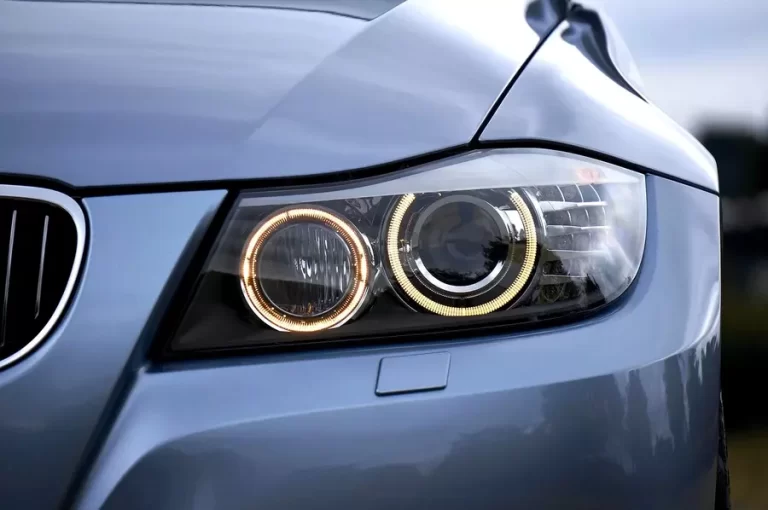
Do you wish you had those cool blueish, super-bright headlights, instead of your dingy (in comparison) yellow lamps? Well, you can, and you can install them yourself (for the most part). But know this, there are a lot of pros and cons for this task, so read on.
First, let’s explain the “color” of headlights. Traditional headlights are more yellow because they operate just like a regular light bulb. The newer LED headlights offer different bulb colors based on the Kelvin temperature scale. The warm-white end of the scale is around 2,500k and the cool-white (blueish) end is around 5,000k. The scale goes up from there, but that’s getting really blue, and in some states, you’ll get a ticket and a removal order.
Reflector headlight bulbs utilize a parabolic (concave) mirror right inside the bulb, to amplify the light source and reflect it through the headlight lens using additional, precisely positioned mirrors and lenses to produce the focus and spread of the headlight for either side of the car.
Projector headlights utilize a light beam that faces directly forward and through a magnifying glass-like lens in the headlight assembly. Interestingly, there is a shield right in front of the bulb that protects oncoming drivers from the glare an unshielded lamp would produce. (This is similar to a spotlight at a concert practically blinding you.)
Typically, projector headlights cost more but lay down a more-even light on the road. Reflector headlights are cheaper and smaller, but will most likely not have the same even coverage on the street as projectors.
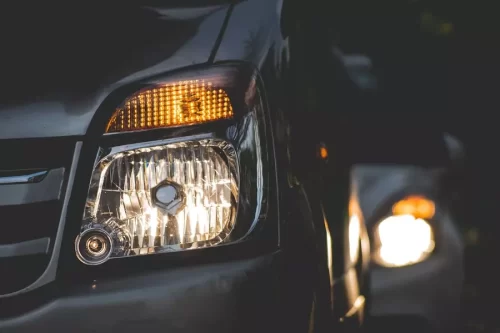 Halogen Bulbs contain one or two filaments, the first for low beams, and the second for “brights”. These filaments are made of tungsten, and virtually identical to those in a traditional incandescent light bulb. But in these bulbs, instead of a vacuum, there are pressurized gasses, that include halogen as iodine or bromine. This allows the tungsten filament to burn brighter and longer than without the gas and prevents the inside of the bulb from blackening from the heat. Some sneaky halogen bulbs come with a blue coating on the bulb to make it “appear” brighter than it actually is. These bulbs start as low as $20 each, but they burn hot, and last a wide range from 500 to 1,000 hours depending on the brand. (Here, you definitely get what you pay for.)
Halogen Bulbs contain one or two filaments, the first for low beams, and the second for “brights”. These filaments are made of tungsten, and virtually identical to those in a traditional incandescent light bulb. But in these bulbs, instead of a vacuum, there are pressurized gasses, that include halogen as iodine or bromine. This allows the tungsten filament to burn brighter and longer than without the gas and prevents the inside of the bulb from blackening from the heat. Some sneaky halogen bulbs come with a blue coating on the bulb to make it “appear” brighter than it actually is. These bulbs start as low as $20 each, but they burn hot, and last a wide range from 500 to 1,000 hours depending on the brand. (Here, you definitely get what you pay for.)
LED Lamps, technically are not bulbs at all, but light-emitting diodes, which are electroluminescent. Essentially a charge is applied to a special type of semiconductor diode, which responds by releasing photons in the form of visible light. LED headlight bulbs are essentially the same as LEDs in all the other electronics you use… just on steroids. They are quickly becoming the standard in all vehicle applications from turn signals to brake lights and even most dashboards. Because they can be built in far more compact designs, car headlights are evolving into much slimmer designs. They are also far more energy efficient than halogen bulbs, and last longer… but at a greater price. Quality LED bulbs start at $50 each but can last 10,000 to 20,000 hours on average.
FRASER PRO-TIP: LED lamps burn even hotter than halogen bulbs, and the cheaper you get the more likely they will burn out a lot faster than the quality brands. (See those fins on the bottom of the LED bulb in this image, those are head-dissipating. Some LED lamps even have tiny little fans mounted on the back of those fins to cooling aid air flow.)
Xenon bulbs, also known as High-Intensity Discharge (HID) bulbs are composed of exotic xenon and argon mixed with vaporized metals that when charged, emit extremely bright light. Often appearing on luxury brands, Xenon/HID bulbs are the original blueish bulb and were a status delineator between their cheaper counterparts. Think Lexus vs. Toyota or Acura vs. Honda. These bulbs do have two downfalls. First, they take a bit to reach their full brightness when turned on. Second, they can be so bright, they could blind drivers in oncoming traffic, especially in situations of fog, rain, or snow. Their one glowing claim is because they have no filament, they can last for years. Expect to pay upwards of $100 per bulb.
Laser headlights, (yes they have tiny little lasers in them) are starting to emerge in premium brands like Audi and BMW. The concept departs quickly from the idea of having lasers shoot out of the front of your car like a rifle scope. Automobile laser headlights produce light through a process of chemiluminescence, or a chemical reaction to an electrical charge. These lasers are reflected in and around a small chamber filled with gas, and the light produced is focused, (projected), with great accuracy and brightness to the road. Laser lights are even more efficient than LEDs producing 1,000 times greater light on half the energy consumption of LEDs. They are also ten times smaller. The downside is they produce the most head of any type of car headlight and need to be housed in propriety casings like the original round and square headlights of the 70s. And, they can only be used as high beams, so the car has to have a set of halogen/zenon/LED lights for low beams as well. Impressively, they are also the longest-lasting, with a 50,000-hour lifespan. So, if money means nothing to you, there are laser headlight kits available but expect to pay thousands for them.
This is the easy part. Fraser strongly recommends starting at your local auto parts store. Use their expertise in selling these different kinds of bulbs every day to guide you in your choices. We would certainly recommend trying a blue-tinted halogen first and see if that quenches your yearning for a cooler, more modern headlight. If not, we would jump to Xenon/HID before LED, mainly because of the lifespan of the bulb. And then, of course, you can experiment with different LED lamps, but again there’s a caveat. Different LED lamp configurations can require separate step transformers and wiring harnesses. This is not for the casual DIY person.
Installation is actually easier than choosing the headlight that’s best for you. Virtually all post-1990 cars use a headlight enclosure and a separate bulb. So, on the back of your headlight is a little rubber cover, also known as a boot, under which is a plug very similar to that on an extension cord. You pull off the plug to expose the prongs of the bulb, then release two wire retaining clips and slide the bulb out of the housing. Do these steps backward to install the new bulb. It’s that easy.
FRASER PRO-TIP: We strongly recommend cleaning the contact points on the back of the headlight housing and the rubber boot cover. Use something stronger than Windex, like Krud Kutter, to clean off the road grime, and then treat the rubber with Armour All or 303 Protectant. And REMEMBER to spray your products on your rag, not near or on the back of the open headlight assembly. Spots inside your headlights are impossible to remove.

Great Movie-Based Model Cars To Build with Your Child Watch a great movie on Christmas Eve, and build the model together on Christmas Day! What
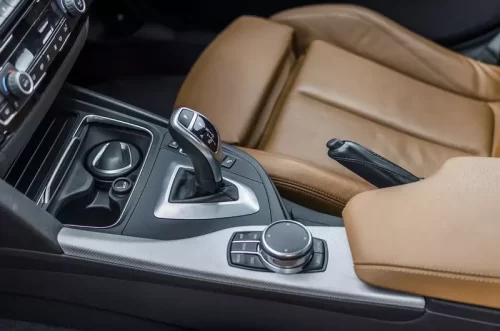
Issue 9 • Engine & Transmission Tips Tell-Tale Signs, It’s Time For A Transmission Rebuild or Replacement NOTE: For editorial purposes, the information below applies

Issue 34 • Engine & Transmission Tips There is more to winterizing your car than adding winter wiper blades. The smart driver does a set

Amity Island Police Chief Brody’s 1975 Chevy Blazer The topless Blazer was cool as heck on a hot Summer beach! While the blockbuster movie JAWS
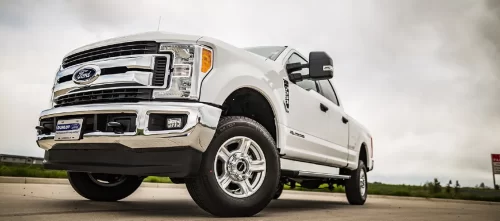
Hello there, truck enthusiasts and Ford loyalists! Fraser Engines here, ready to dive into the world of trucks that embody the American spirit—the Ford Super
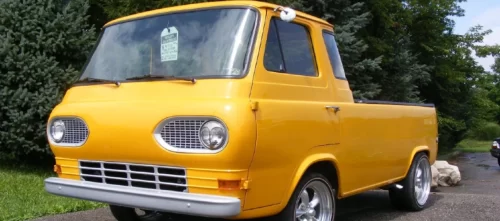
The Ford Econoline, also known as the E-Series, holds a special place in the automotive landscape as one of the most recognizable and versatile vans